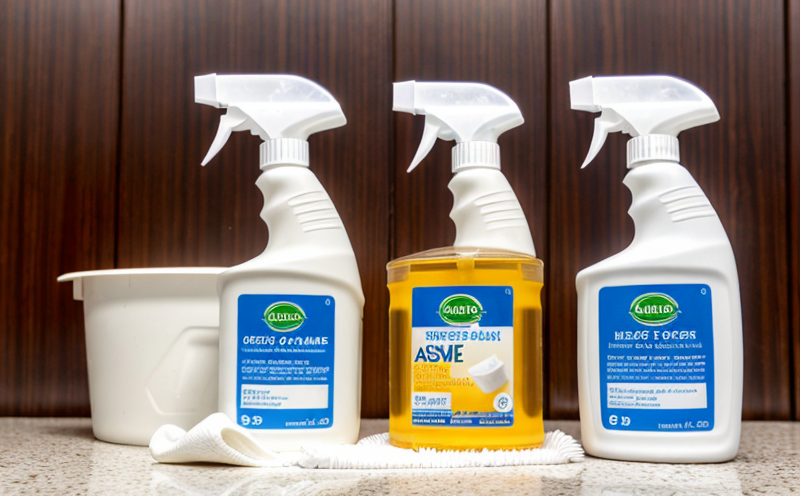AOAC 955 Bactericidal Testing of Disinfectant Products
The AOAC International standard method AOAC 955 is widely recognized for evaluating the bactericidal efficacy of disinfectant products. This test assesses a product's ability to kill bacteria under specified conditions, ensuring that the product meets regulatory and quality standards necessary for use in healthcare settings, food processing plants, and other critical environments.
The method involves inoculating a known quantity of test organisms onto agar plates or into broth media. The disinfectant is applied to these inoculated specimens according to predefined protocols, and then incubated under controlled conditions. After the specified contact time, additional samples are tested for viable bacteria using appropriate microbiological techniques.
The primary objective of this testing process is to ensure that a disinfectant effectively reduces or eliminates bacterial contamination within acceptable limits. This is crucial not only from an efficacy standpoint but also in terms of consumer safety and regulatory compliance. The test results provide critical data regarding the product's performance, which can inform ongoing improvements in formulation and manufacturing processes.
For instance, in healthcare settings, ensuring that disinfectants are effective against hospital-acquired pathogens like Staphylococcus aureus or Listeria monocytogenes is paramount. The AOAC 955 method allows laboratories to verify these claims by providing quantitative data on bacterial reduction.
The testing process itself involves a series of meticulous steps, including precise specimen preparation and careful adherence to the standardized methodology. This ensures that the results are both reliable and reproducible, which is essential for maintaining trust in the disinfectant market.
Regulatory bodies such as the U.S. Environmental Protection Agency (EPA) and the Centers for Disease Control and Prevention (CDC) often require compliance with methods like AOAC 955 to ensure public health protection. Compliance not only helps manufacturers meet regulatory requirements but also enhances brand reputation, fostering consumer confidence in product safety.
In summary, the AOAC 955 test is a cornerstone of bactericidal efficacy evaluation for disinfectant products. It provides critical data that informs both product development and quality assurance efforts, ensuring that these crucial products perform as expected in real-world applications.
Why It Matters
The AOAC 955 method is essential for several reasons:
- Consumer Safety: Ensuring that disinfectants are safe and effective in reducing bacterial contamination is critical for protecting public health.
- Regulatory Compliance: Compliance with recognized standards like AOAC 955 helps manufacturers meet regulatory requirements, which is crucial for market entry and ongoing product approval.
- Informed Product Development: The test results provide valuable insights into the performance of disinfectant products, guiding improvements in formulation and efficacy.
The data generated from this testing process can also influence broader industry standards and practices, contributing to advancements in hygiene and infection control measures.
Why Choose This Test
Selecting the AOAC 955 method for bactericidal testing offers several advantages:
- Rigorous Standardization: The method is based on stringent international standards, ensuring consistent and reliable results across different laboratories.
- Comprehensive Coverage: It covers a broad range of test organisms, providing comprehensive data that reflects real-world conditions.
- Scientific Rigor: The protocol includes detailed instructions for specimen preparation and testing procedures, minimizing variability in results.
The AOAC 955 method is particularly beneficial for manufacturers seeking to ensure the safety and efficacy of their disinfectant products. By choosing this test, companies can demonstrate a commitment to quality and regulatory compliance, thereby enhancing brand reputation and consumer trust.
Quality and Reliability Assurance
The AOAC 955 method is underpinned by robust quality assurance protocols that ensure the reliability of results. These include:
- Precision Specimen Preparation: Careful preparation of specimens ensures that the test accurately reflects the product's real-world performance.
- Standardized Testing Procedures: Each step in the testing process is meticulously documented and followed, reducing the potential for human error.
- Detailed Reporting: Comprehensive reports are generated, providing detailed insights into the bactericidal efficacy of each product tested.
The use of advanced microbiological techniques further enhances the accuracy and reliability of the test results. This commitment to quality is reflected in the consistent compliance with international standards such as ISO 18173:2019 for testing procedures.
By adhering to these stringent protocols, laboratories ensure that the AOAC 955 method provides reliable, accurate, and reproducible data, which is critical for maintaining trust in the disinfectant market and ensuring regulatory compliance.





